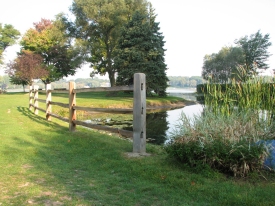Under the Natural Resources and Environmental Protection Act (Public Act 451 of 1994, Part 309, Inland Lake Improvements), lake board membership includes representatives from the following entities: Bloomfield Township, two designees; Oakland County Board of Commissioners; Oakland County Water Resource Commissioner’s Office; and a riparian land owner, appointed by the lake board, who owns land abutting the lake. Lake improvement boards have been established to address relevant lake improvement issues, including the oversight of aquatic weed control programs, nuisance control, water quality improvements and other educational activities.
For more information regarding the Township’s eight established lake boards, engineering studies or maps of each lake board area, please select a link below.
Volunteer Water Quality Monitor Program for Inland Lakes
| Lake Boards | Year Formed |
|---|---|
| Forest Lake | 1986 |
| Gilbert Lake | 2007 |
| Island Lake | 1983 |
| Lower Long Lake | 1985 |
| Meadow Lake | 1986 |
| Orange Lake | 2003 |
| Upper Long Lake | 1984 |
| Wabeek Lake | 1989 |

As of March 1, 2005, Michigan legislative amendments have made new changes to the administration structure of lake improvement boards. For more information, please see the Natural Resources and Environmental Protection Act - Public Act 451 of 1994, Part 309.
For more information, please visit the Oakland County Lake Improvement Board website for access to the Lake Improvement Board manual.
Upcoming Lake Improvement Board Public Hearings
*Alternate location at Bloomfield Community Television, 4190 Dublin Rd. due to renovations in Township Hall Auditorium.
Water Quality
 Lakes are commonly classified as oligotrophic, mesotrophic, or eutrophic.
Lakes are commonly classified as oligotrophic, mesotrophic, or eutrophic.
Oligotrophic lakes are generally deep and clear. They have little aquatic plant growth and have high levels of dissolved oxygen in the bottom waters of the lake even during late summer. These lakes can support cold water fish species such as trout or steelhead.
Mesotrophic lakes are characterized by intermediate aquatic plant growth. This causes some organic sediment to fall to the bottom of the lake. Thus, dissolved oxygen levels are typically lower near the bottom of this type of lake. The water is clear and can support moderately heavy fishing pressure. Depending on the depth of the lake it may support warm or cold water fish species.
Eutrophic lakes are usually shallow and turbid and support abundant plant growth. In most eutrophic lakes the bottom waters are cool and contain little or no dissolved oxygen. These lakes support only warm water fish species including bass and pike.
Under natural conditions, most lakes will evolve into eutrophic lakes. They gradually fill in with sediment and organic matter carried into the lake from its surrounding watershed (area of land drained by a river or lake system). As the lake becomes shallower the process of lake aging or eutrophication will accelerate. Over time, the lake will age into a marsh or swamp.
The eutrophication process can be further enhanced by the addition of unnatural amounts of sediment and nutrients. This unnatural addition is usually the result of human activities within the watershed and is called cultural eutrophication. This issue can be addressed by the identification and elimination of sources of nutrient and sediment loading.
Water Quality Parameters
Typical water quality monitoring includes the assessment of the physical, biological, and chemical characteristics of the water body.
A physical lake survey involves assessing the apparent condition of the lake. This can include monitoring the temperature, depth, shoreline disruption of a lake. These factors can limit the amount and species of the fish population. In addition, a generalization of surrounding land uses can help to identify sediment and nutrient sources.
Biological lake assessment can tell us a great deal about the quality of water in a lake or river. Typically, benthic macroinvertebrate (bottom dwelling large invertebrates) populations are great indicators for water quality. The number and type of organism found in a water body is directly related to the quality of that lakes water. A comprehensive chemical assessment is important when considering the overall quality of an aquatic environment. Typically, turbidity, nitrate, and dissolved oxygen levels have the greatest impact on water quality.
Turbidity is a measure of the amount of particulate matter that is suspended in water. Water that has high turbidity appears cloudy or opaque. High turbidity can cause increased water temperatures because suspended particles absorb more heat and can also reduce the amount of light penetrating the water.
 Nitrate is a major ingredient of fertilizer and is necessary for crop production. When it rains, varying nitrate amounts wash from farmland into nearby waterways. Nitrates also get into waterways from lawn fertilizer run-off, leaking septic tanks and cesspools, manure from farm livestock, animal wastes (including fish and birds), and discharges from car exhausts. Nitrates stimulate the growth of plankton and aquatic weeds can be beneficial in the lake. However, if algae grow too wildly, oxygen levels will be reduced and fish will die.
Nitrate is a major ingredient of fertilizer and is necessary for crop production. When it rains, varying nitrate amounts wash from farmland into nearby waterways. Nitrates also get into waterways from lawn fertilizer run-off, leaking septic tanks and cesspools, manure from farm livestock, animal wastes (including fish and birds), and discharges from car exhausts. Nitrates stimulate the growth of plankton and aquatic weeds can be beneficial in the lake. However, if algae grow too wildly, oxygen levels will be reduced and fish will die.
Dissolved oxygen (DO) levels can have wide-ranging effects on the health of a water body. DO is a very important indicator of a water body's ability to support aquatic life. Fish "breathe" by absorbing dissolved oxygen through their gills. Oxygen enters the water by absorption directly from the atmosphere or by aquatic plant and algae photosynthesis. Oxygen is removed from the water by respiration and decomposition of organic matter. The amount of DO in water depends on several factors, including temperature (the colder the water, the more oxygen can be dissolved); the volume and velocity of water flowing in the water body; and the amount of organisms using oxygen for respiration. The amount of oxygen dissolved in water is expressed as a concentration, in milligrams per liter (mg/l) of water. Human activities that affect DO levels include the removal of riparian vegetation, runoff from roads, and sewage discharge.
For information about how you can become a better steward for the environment, please visit our Riparian Information webpage.
Please contact the Bloomfield Township Clerk’s office at Clerk's Office Email or 248-433-7702 or the Engineering and Environmental Services Department at EESD Email or 248-594-2800 if you have questions about the material presented here.
